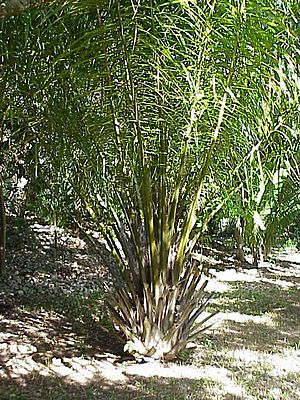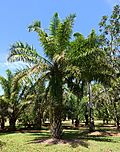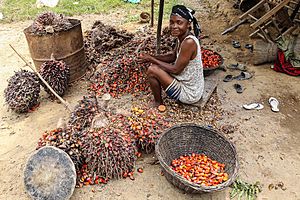Elaeis
Quick facts for kids Elaeis |
|
|---|---|
 |
|
| African oil palm (Elaeis guineensis) | |
| Scientific classification |
|
| Kingdom: | Plantae |
| Clade: | Tracheophytes |
| Clade: | Angiosperms |
| Clade: | Monocots |
| Clade: | Commelinids |
| Order: | Arecales |
| Family: | Arecaceae |
| Subfamily: | Arecoideae |
| Tribe: | Cocoseae |
| Genus: | Elaeis Jacq. |
| Species | |
|
|
| Synonyms | |
|
|
Elaeis is a group of palm trees that includes two types, commonly known as oil palms. The word Elaeis comes from a Greek word meaning "oil." These palms are very important in agriculture because they are used to make palm oil.
The most common type is the African oil palm, called Elaeis guineensis. Its name "guineensis" tells us it comes from Africa. This palm is originally from western and southwestern Africa, found from Angola to Gambia. The other type is the American oil palm, Elaeis oleifera. Its name means "oil-producing." This palm grows naturally in tropical parts of Central and South America. People in those areas use it to make oil.
Contents
What Do Oil Palms Look Like?
Oil palms have a single main stem and can grow very tall, sometimes over 65 feet (20 meters) high. Their leaves are long and feathery, reaching about 10 to 16 feet (3 to 5 meters) in length.
The flowers of the oil palm grow in tight bunches. Each flower is small and has three sepals (like small leaves that protect the bud) and three petals.
The fruit of the oil palm is reddish and about the size of a large plum. These fruits grow in big bunches. Each fruit has an oily, fleshy outer part called the pericarp. Inside, there is a single seed, known as the palm kernel, which is also full of oil.
Types of Oil Palms
There are two main types of oil palms: E. guineensis (African oil palm) and E. oleifera (American oil palm). These two types can even create new, fertile hybrid plants when they cross-pollinate. Scientists have studied the genetic code (the genome) of E. guineensis. This research helps farmers grow even better oil palm plants.
| Image | Scientific Name | Common Name | Where It Grows |
|---|---|---|---|
 |
Elaeis guineensis | African oil palm | West and southwest Africa, from Angola to The Gambia |
 |
Elaeis oleifera | American oil palm | South and Central America, from Honduras to northern Brazil |
How People Use Oil Palms
Growing Palm Oil for Business
Palm oil is used in many foods and products. It has more saturated fats compared to other oils like canola or corn oil. This makes it good for deep-frying because it can handle high heat and doesn't spoil easily. Palm oil also does not contain trans fat, which is why its use in food has grown. Oil from Elaeis guineensis is also used to make biofuel, which is a type of fuel made from plants.
People have used oil palms for a very long time. It's believed that people in coastal west Africa used palm oil about 5,000 years ago. Archaeologists even found palm oil in an ancient tomb in Abydos, Egypt, that dates back to 3000 BCE. It is thought that traders from Arab countries brought the oil palm to Egypt.
Today, Elaeis guineensis is grown widely in many tropical countries outside of Africa. Malaysia and Indonesia are two of the biggest producers, supplying most of the world's palm oil.
Using Palm Fiber
Scientists have found that Elaeis palms can be a cheap source of nanofiber. Nanofibers are tiny, strong fibers. This is especially useful in Indonesia, where there is a lot of leftover plant material (called cellulosic waste) from palm oil production.
Error: no page names specified (help). In Spanish: Palma aceitera para niños
In Spanish: Palma aceitera para niños


